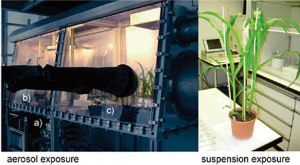Oct 30 2010
Nanoparticles seem to be always on the move: Researchers have observed them navigate across biological barriers and accumulate within single-celled organisms and animal tissues.
Now Swiss researchers find that cerium oxide nanoparticles are less nimble in corn plant tissue, which suggests that they might not pose a threat to the food crops themselves or to the people who eat them.
 Corn plants exposed to nanoparticle aerosols (left), or watered with nanoparticle-tainted water (right), do not circulate the materials.
Corn plants exposed to nanoparticle aerosols (left), or watered with nanoparticle-tainted water (right), do not circulate the materials.
Although scientists lack clear data on crop exposure to nanoparticles, the chemicals may reach the crops through wastewater runoff used in irrigation. Ludwig Limbach and his colleagues wanted to understand how the cell wall encircling plant cells might affect their ability to absorb the chemicals. Few studies have examined nanoparticle exposure in plants, especially under environmentally relevant conditions, says Limbach, a postdoctoral researcher at the Swiss Federal Institute of Technology, Zurich (ETH). Earlier studies had shown root uptake of metal oxide nanoparticles, but they used plants grown hydroponically, not in soil.
So the researchers simulated the delivery of nanoparticles through wind and soil. They studied corn plants because of their importance as a food crop. And they picked cerium oxide nanoparticles, which industry produces on a multi-ton scale, as a model system.
To create the wind conditions, the researchers produced an aerosol of cerium oxide nanoparticles in a closed chamber that also contained one-month-old plants. They then washed some plants with water to mimic rain. Using inductively coupled plasma mass spectrometry, the researchers found that the washed plants had absorbed the nanoparticles into their leaves.
Three months after the aerosol exposure, the older leaves still retained nanoparticles. But new leaf growth contained no detectable cerium, which suggests that the nanoparticles had not moved into those leaves from other parts of the plant.
For the soil exposure conditions, the researchers watered maize plants with suspensions of cerium oxide nanoparticles twice daily for two weeks. Throughout the experiment, the particles did not move from the roots into the stem or leaves. But Limbach says that the soil may have filtered out nanoparticles, so the team plans to follow up with hydroponic studies to rule out soil's effects.
The study's "careful methods" convinced Peter Neumann of the Technion-Israel Institute of Technology that most nanoparticles cannot penetrate deeply into plant tissues or circulate through their vascular systems.
But, despite the researchers' care, Pu-Chun Ke of Clemson University cautions that detecting the transport of nanoparticles within plants is still a tremendous analytical challenge, so he would not rule out the possibility that they might transport a small amount of cerium oxide. Other plant species and nanoparticles with other chemical compositions might show different interactions, he adds, suggesting the need for continued research.
Source: http://pubs.acs.org/